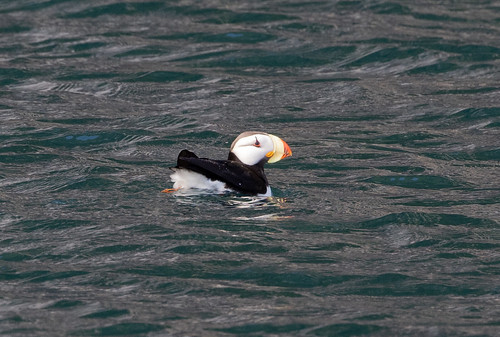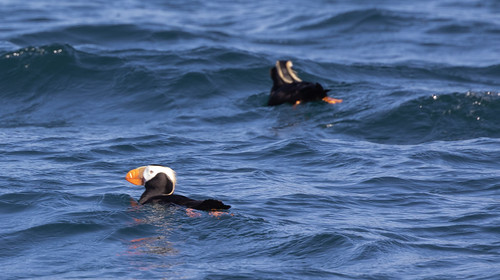The natural world is rich beyond our wildest imaginings—so much so that the greatest, most well-traveled naturalists in the world could never experience more than a fraction of the different species of plants and animals that live on this planet. Schools are woefully inadequate at teaching children about even the most abundant plants and animals living right in their own state or town. So I’m happy when someone knows what puffins are without confusing them with completely unrelated penguins.
Puffins and penguins are polar opposites, geographically speaking, though penguins range much further from the Antarctic Circle than puffins do from the Arctic Circle—indeed, the Galápagos Penguin nests north of the Equator, while the furthest south any puffin ranged historically was the Tufted Puffin nesting on the Channel Islands at about 34º latitude. Sadly, the last confirmed report from the Channel Islands was in 1997.
Like penguins, puffins spend every moment of their lives at sea except during their nesting season. Two countries on earth get to enjoy all three puffin species—Canada and the United States. No country is home to all 17 or so species of penguins.
The Tufted Puffin is the largest of the three and the one most closely resembling penguins, at least crested penguins such as rockhoppers. Tufted Puffins are pretty easy to see swimming in coastal waters in late summer. On this side of the Pacific, they breed on offshore islands and rocky shoreline cliffs from Alaska through central California. I saw my lifer from a fishing boat off the coast of Newport, Oregon in August 1979; Russ and I saw plenty on our Inside Passage cruise in August 2001; and I saw them on two Shearwater Adventures pelagic trips in California in September 2013 and 2019. But my best viewing ever was on the 8 1/2 hour boat trip from Seward, Alaska, into the Kenai Fjords this year.
Horned Puffins, which nest only in the far north and spend most of their lives pretty far offshore, were much harder to come by. I saw my lifers, the only two Horned Puffin I ever saw until this year’s Alaska trip, near the end of our Inside Passage cruise after spending hours every day scrutinizing every bird I could see swimming, flying, or sitting on cliffs offshore. I saw them this year in Nome, but aways at a distance, flying. My best views were from the boat out of Seward to Kenai Fjords.
I saw my lifer Atlantic Puffin in 1993 when Russ and I brought our children to Machias Seal Island in Maine. That splendidly remote island, where puffins, Razorbills, and Common Murres nest in big numbers, is the site of a Canadian Coast Guard station, even though the United States claims the island belongs to us. Since no people live on it and no oil or precious metals have, at least so far, been found on it, the United States and Canada have not come to blows over ownership.
Nowadays, a boat from the Bold Coast Charter Company, bearing a U.S. flag, travels from Cutler Harbor in Maine to Machias Seal Island once a day from the very end of May through early August, during the brief time of year that puffins are nesting.
The boat takes 45 minutes to an hour to travel to the island. When sea conditions allow a safe landing, passengers get to go onto the island, staying in very restricted areas and narrow walkways to observation blinds to see these stunning birds up close and personal. The number of participants and the walking routes and blinds are tightly regulated to protect the birds. The rest of the year, the puffins are all out at sea.
I’ve got a bazillion photos of Atlantic Puffins, some from slides we took in 1993 and some from boat trips when I was an instructor on Audubon’s Hog Island in Maine, but the best are from my Big Year when I took that Bold Coast boat trip to Machias Seal Island. Conditions were perfect that day. I doubt I’ll ever have such amazing conditions for photographing the two western puffins, and only got a few good photos of both of them on this year’s trip, but that was plenty good enough for me.










